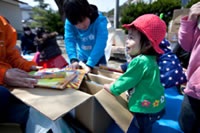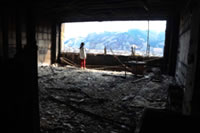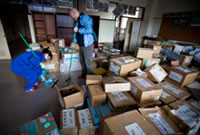



[TOKYO, Japan, 11 April 2011]
Exactly one month has passed since the Great East Japan Earthquake shook the world and the extent of the damage still remains unclear. The Japan Committee for UNICEF (JCU) entered the disaster area directly following the earthquake and has been continuing assistance activities for children while surveying local needs ever since.
 |
| © Japan Committee for UNICEF /2011/Grehan |
In response to the massive damage caused by the giant earthquake and tsunami that struck northeastern Japan on Friday, 11 March, JCU for the first time in history decided to implement assistance in Japan, launching fundraising activities two days later on 13 March. The same night UNICEF Executive Director Anthony Lake announced that, “Working in close cooperation with the Japan Committee for UNICEF, we have offered our support to protect the children affected by this catastrophe and to provide critical services in the days ahead.” With the full support of UNICEF, JCU has dispatched Japanese staff from UNICEF to the disaster site, implemented assistance activities and procured relief supplies in response to the disaster.
The Great East Japan Earthquake Emergency Response Headquarters, which is set up at the UNICEF House in Tokyo, and local teams in Miyagi and Iwate Prefectures are doing everything they can to provide assistance to children in the affected areas while working together with the Japanese Government, municipal governments and NPOs and other civil society.
JCU has delivered drinking water, children’s underwear, diapers, shoes and other emergency relief supplies to disaster victims in Miyagi, Iwate and Fukushima Prefectures while coordinating with the respective Disaster Response Headquarters in each prefecture. A large number of donations of necessary supplies were made for these activities by JCU’s partner organizations. Cooperation was also received for the transport of these supplies. Please see the chart below for an update on the status of the arrival of relief supplies.
We will continue to provide disaster victims with relief supplies that meet local needs.
 |
| © Japan Committee for UNICEF /2011/k.shindo |
| Otsuchi Primary School in Iwate Prefecture. |
In the one month since the disaster, local needs are have shifted from emergency rescue services to healthcare and nutritional services mainly for the vulnerable, including pregnant women, infants and the elderly. While medical services and water supplies are adequate at shelters, adequate assistance is not reaching disaster victims that have returned home or stay smaller shelters with poor access. The role of municipal governments is vital in administering healthcare assistance, however, city government buildings and healthcare personnel that are central to such assistance are also victims of this disaster, making it very difficult to implement adequate healthcare services.
Against this backdrop, since the earthquake local teams implementing activities in Miyagi and Iwate Prefectures have continued working in efforts to achieve reconstruction at the earliest stage possible. Specifically, these teams have been providing technical assistance to Disaster Response Headquarters’ in both prefectures, implementing local needs assessments, forming partnerships to provide medical services, including for visiting medical teams, and constructing mid- to long-term healthcare systems.
JCU is also advancing cooperation with expert groups from Japan in implementing activities that support mothers and infants, which are the most vulnerable in disaster situations. UNICEF Tokyo Office and an organization promoting breastfeeding issued the Declaration supporting safe and proper infant nutrition (See Note 1) and the Policy regarding infant nutrition during times of disaster (See Note 2). Moreover, under the Temporary Evacuation Project for Infants, friendly spaces are being provided for mothers and infants in Niigata Prefecture.
 |
| © Japan Committee for UNICEF /2011/Grehan |
| A primary school in Onagawa, Miyagi Prefecture. |
As a result of the disaster many schools were left totally or partially destroyed, and the school buildings that were left intact have been used as shelters. Schools are not only places where children learn new things; rather, they are important places where children play with friends and are able to act like the children that they are.
JCU is providing assistance under the Back to School campaign so that children are able to return to the schools where they belong as quickly as possible. Specifically, JCU is coordinating with related personnel including from local boards of education in order to provide schoolbags, school stationery and other supplies necessary for reopening schools in time for the April entrance and opening ceremonies.
There are concerns that the extensive damage of the Great East Japan Earthquake will have negative psychological effects on children. These children suffered through the terrible experience of a massive earthquake and tsunami, and are now showing heightened levels of stress and anxiety as they are forced to live in an unfamiliar shelter setting, must tolerate more change than usual and cannot play freely.
JCU has established Child Friendly Spaces at more than 10 shelters in order to facilitate psychological assistance for children. While using Early Childhood Development Kits and recreation kits—tools received from the UNICEF Supply Division in Copenhagen—we have helped children in returning normality to their everyday lives.
Working towards the reopening of schools, shelters in the disaster area are beginning to gradually consolidate themselves and preschoolers are returning to kindergartens and preschools. In accordance with these developments, JCU has cooperated with organizations specializing in play therapy to provided training to over 130 kindergarten and preschool teachers and parents as well as volunteers at Child Friendly Spaces. Individuals that partook in the training are looked to to exercise what they have learned in providing psychological assistance for children in the disaster area.
Moreover, thanks to generous assistance from many organizations and individuals, JCU received a significant amount of donations in the form of picture books and kami shibai (Japanese picture card stories) for the UNICEF Children’s Mini Library project. These Mini Libraries have already been set up at over 60 Child Friendly Spaces, kindergartens and schools. Furthermore, procedures to send more UNICEF Children’s Mini Libraries are moving forward, and these libraries are reaching children in the disaster area on a continual basis.
JCU and the UNICEF Tokyo Office announced the Outlook on alternative care for children orphaned as a result of the Great East Japan Earthquake (See Note 3), which addresses providing assistance to orphans in the Tohoku region. This Outlook is based on international treaties such as the Convention on the Rights of the Child and legal frameworks of the Japanese Government. We will continue to provide assistance in order to implement measures that serve the best interests of children.
Cooperation from the general public and of partner institutions has been vital in implementing assistance activities in response to the Great East Japan Earthquake. Since the launch of fundraising activities for domestic assistance activities, JCU has raised 900 million yen in donations.
With the support of UNICEF, JCU will continue to provide assistance while working together with the national Government, municipal governments, schools, preschools, kindergartens, hospitals and other related institutions in order to develop an optimal environment for children.
| Note 1: | Declaration supporting safe and proper infant nutrition (Japanese only) |
| Note 2: | Policy regarding infant nutrition during times of disaster (Japanese only) |
| Note 3: | Outlook on alternative care for children orphaned as a result of the Great East Japan Earthquake (Japanese only) |
| Receiving Prefecture |
Type of Emergency Supplies |
Arrival Date |
Quantity | Donating Company |
Comments |
|---|---|---|---|---|---|
| Miyagi | Water | 19 Mar. | 12,288 bottles |
VanaH Co., Ltd. | Two-liter plastic bottles |
| Fukushima | Water | 22 Mar. | 12,672 bottles |
VanaH Co., Ltd. | Two-liter plastic bottles |
| Miyagi | Underwear for boys and girls | 22 Mar. | 200,000 | ||
| Iwate | Underwear for boys and girls | 23 Mar. | 30,000 | ||
| Fukushima | Water | 23 Mar. | 4,680 bottles |
KIRIN MC DANONE WATERS Co., Ltd. | Two-liter plastic bottles |
| Miyagi | Children’s shoes | 23 Mar. | 10,000 pairs |
||
| Miyagi | RChildren’s diapers | 24 Mar. | 80 packs | P&G Japan | |
| Iwate | Children’s underwear | 24 Mar. | 9,700 | ||
| Fukushima | Water | 24 Mar. | 12,288 bottles |
VanaH Co., Ltd. | Two-liter plastic bottles |
| Iwate | Shoes | 26 Mar | 1,404 pairs | Achilles Corporation | |
| Iwate | Underwear for boys and girls | 27 Mar. | 28,266 | ||
| Iwate | Boots | 27 Mar. | 7,462 pairs | ||
| Iwate | Wipes | 28 Mar. | 1,200 | P&G Japan | For babies |
| Miyagi | Recreation kits Early Childhood Development kits |
2 Apr. | 50 of each | Procured from the UNICEF Supply Division | |
| Iwate | Recreation kits Early Childhood Development kits |
2 Apr. | 50 of each | Procured from the UNICEF Supply Division | |
| Miyagi | Book bags | 6 Apr. | 70 | Nihon New Bag Chain | |
| Iwate | Book bags | 6 Apr. | 340 | Seiban | |
| Miyagi | Schoolbags | 8 Apr. | 18,000 | Procured from the UNICEF Supply Division | |
| Iwate | Schoolbags | 8 Apr. | 18,000 | Procured from the UNICEF Supply Division | |
| Miyagi | Personal security buzzers (for crime prevention purposes) | 8 Apr. | 5,000 | ||
| Iwate | Personal security buzzers (for crime prevention purposes) | 8 Apr. | 5,000 |
*In certain cases some supplies may be taken from prefectural supply storage warehouses and distributed to shelters and disaster sites in other prefectures.
As of 9:00 a.m. on 8 April 2011 (compiled by the Information and Public Affairs Division).